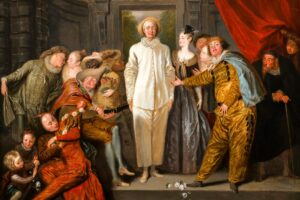A Gentleman in Quiet Reflection
In this serene and noble portrait, Charles Gauffier captures a moment of stillness—a thoughtful pause in the life of Count Gustaf Mauritz Armfelt. Once a diplomat, military man, and trusted advisor to kings, Armfelt now sits in quiet exile in Florence. The war and politics of Europe swirl beyond the hills, but here, he is alone with his thoughts, his books, and his ideals.
History at His Side
To his left rest two busts—one golden, one dark. They symbolize the twin forces of reason and power. One bears the features of Julius Caesar, conqueror and statesman. The other, less defined, may hint at a philosopher, or the ideal of wisdom itself. Between them lies an open book and a quill—tools not of war, but of diplomacy, letters, and thought.
A Look Toward the Horizon
Armfelt is not slouched in sorrow. He sits upright, hands gently clasped over his lap, gaze lifted as if watching the light move across the hills. The window behind him opens to the green landscape of Tuscany—a place far from his native Sweden, yet touched by beauty, calm, and the echoes of ancient Rome. The curtain is drawn just slightly, as if letting in a breeze of new ideas.
The Symbol of the Star
Pinned to his coat is a silver star, a mark of honor and service. Though his power may be gone, his dignity remains. The blue ribbon near his knee recalls the Order of the Seraphim, Sweden’s highest award. Even in exile, he wears it not as decoration, but as memory and promise.
The Wisdom of Stillness
This portrait is not about action, but presence. About a man who has known courts, armies, and revolutions—and now listens more than he speaks. It tells us that greatness is not only found in grand acts, but in how one endures loss, contemplates life, and holds fast to inner truth.
A Timeless Image of Character
In Portrait of Count Gustaf Mauritz Armfelt in Florence, Gauffier offers us more than likeness. He paints a spirit shaped by history and calm strength—a man who, though far from home, remains grounded in honor, thought, and the timeless legacy of ideas.
About Artist

Louis Gauffier (1762–1801) was a French painter of the Neoclassical period. A student of his older brother, Henri Gauffier, and a protégé of the renowned Jacques-Louis David, he was known for his elegant portraits and historical scenes. Gauffier spent a significant portion of his career in Italy, particularly in Rome and Florence, where he was heavily influenced by classical sculpture and Renaissance art. His work is characterized by its refined drawing, clear composition, and a more delicate, less severe style than his mentor David.
Artistic Style and Legacy
Gauffier’s style reflects the core principles of Neoclassicism, but with a personal touch. His art is distinguished by:
- Purity of Line: Like other Neoclassical artists, he placed great importance on the precision of his lines and the sculptural quality of his figures.
- Refined Realism: His portraits, in particular, are celebrated for their meticulous detail and their ability to capture the dignity and character of his sitters without the rigid formality seen in some of his contemporaries.
- Classical Allusions: He often incorporated elements from classical antiquity, such as sculptures or ruins, into his portraits and landscapes, grounding his work in the traditions of the past.
Despite his promising career, Gauffier died young in Italy, which limited his overall output and contributed to his work being less widely known than that of David or Ingres.
Notable Works
- Portrait of Count Gustaf Mauritz Armfelt (1790s): This painting is a beautiful example of Gauffier’s refined portraiture. It depicts a Swedish statesman and diplomat in an elegant pose, with a sense of both dignity and approachability.
- Portrait of André-François Miot (1790s): This work is another testament to his skill in capturing the character of his subjects. The portrait of the French diplomat and writer is known for its sense of quiet intellect and elegant composition.



